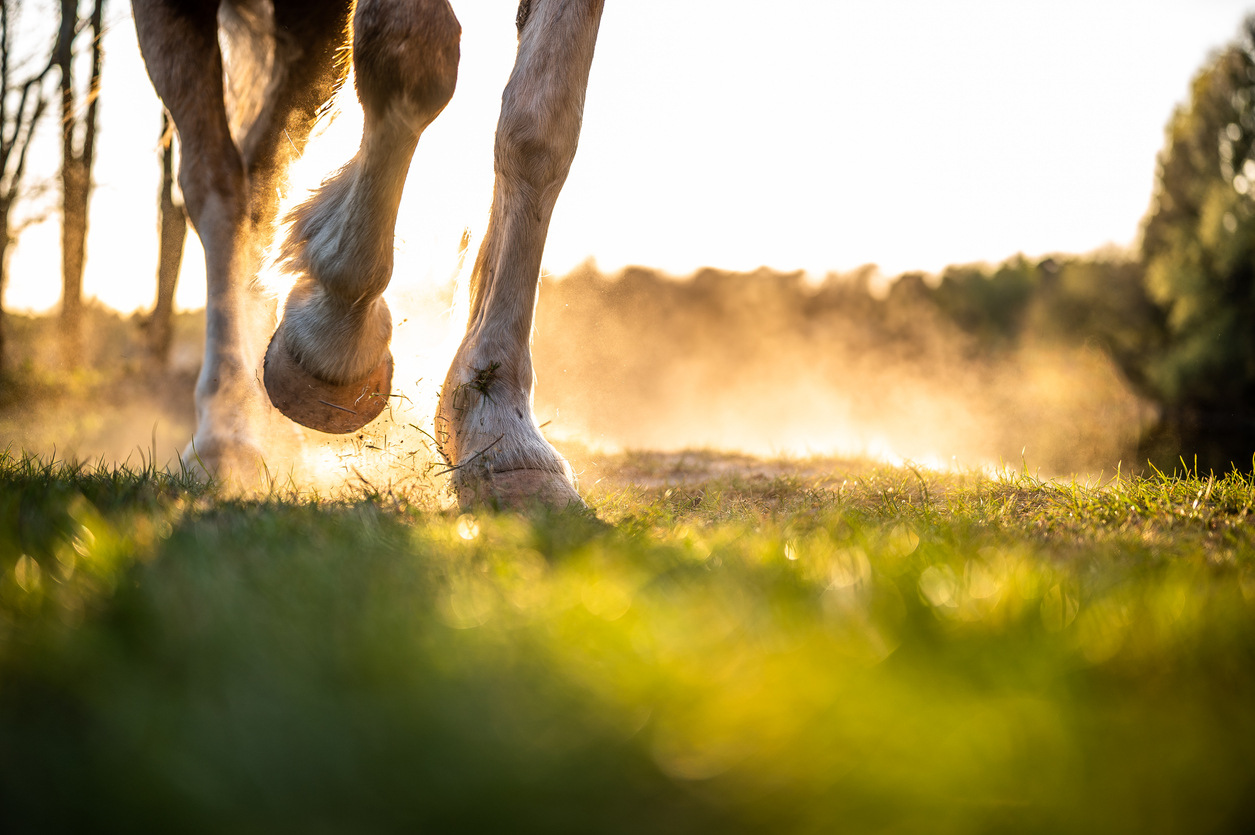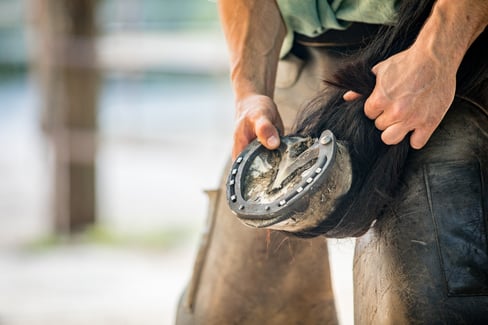Table of Contents
Much like a well-polished shoe completes an outfit, proper horse hoof care is essential for our four-legged companions' overall health and performance.
In this comprehensive blog post, we'll trot through common issues that can plague our equine friends' hooves, from pesky cracks to irksome thrush, with the finesse of a farrier and the precision of a podiatrist.
We'll explore key considerations, care tools, and the best horse hoof care supplements and products to shape the foundation of your beloved horse's health.
After all, horse hoof care doesn't have to be a hoof-stomping ordeal; it can be as delightful as a graceful canter through a sun-kissed meadow.
Importance of Horse Hoof Protection
In equine care, few facets are as important and often underestimated as the welfare and safeguarding of adult and baby horse hooves.
More than just a means of locomotion, a horse's hooves are a vital indicator of its overall health and happiness. Protecting your horse’s hooves from different surfaces is a standard part of conscientious horsemanship.
Horse hooves absorb the concussive impact of the horse’s movements, allowing for safe and easy movement on different types of surfaces like concrete, grass, and hard-packed dirt—all of which are usually found on a ranch or farm. A healthy hoof is imperative for protecting and preventing secondary leg and body injuries.
Here is a comparative table outlining various aspects of horse hoof health and the implications of neglecting proper maintenance:
|
Aspect of Hoof Health |
Importance |
Implications of Neglect |
|
Shock Absorption |
Absorbs concussive impact |
Increased risk of injury and lameness |
|
Weight Bearing |
Supports the horse's weight |
Hoof damage and lameness |
|
Protection |
Shields against external elements |
Vulnerability to infections and injuries |
A horse, with an average weight surpassing 1,000 lbs or roughly 450 kgs, relies on four hooves scarcely larger than a human hand to support its massive frame.
The age-old adage "no hoof, no horse" resonates through generations of horse lovers, highlighting the critical nature of hoof maintenance. Without diligent care, your beloved mare or stallion, celebrated for its mobility, would be severely limited in its movement, emphasizing the indisputable importance of prioritizing hoof health.
Common Horse Hoof Issues
A steed's sturdy yet delicate hooves are the foundation for its mobility, performance, and overall comfort. However, horse hooves, especially newborn horse hooves, are susceptible to various issues affecting their function and integrity like any other body part.
This section looks at common horse hoof issues and their causes to give insights into improving your four-legged friend's well-being.
Cracked Hooves
Cracked hooves are a common concern among horse owners, ranging from superficial surface cracks to deep fissures compromising hoof integrity. Symptoms often include visible cracks or splits in the hoof wall, lameness, or discomfort.
Cracked hooves can occur due to various reasons, including:
- Environmental factors: Changes in weather conditions, such as prolonged exposure to wet or dry environments, can affect the moisture content of the hoof, leading to cracks.
- Improper trimming: Irregular trimming or incorrect trimming angles can result in uneven weight distribution and increased stress on specific areas of the hoof, predisposing it to cracking.
- Nutritional deficiencies: Inadequate levels of essential nutrients, such as biotin and zinc, in the horse's diet can weaken the hoof structure, making it more susceptible to cracking.
- Trauma: Direct trauma to the hoof, such as from excessive force or impact, can cause cracks to develop.
Prompt intervention and appropriate horse hoof care treatment are vital in promoting healing and preventing further damage to the structural integrity of the hoof. Working closely with a qualified farrier and veterinarian ensures your horses receive the necessary care to maintain healthy, crack-free hooves.
Thrush
Thrush, a common hoof ailment, is caused by bacterial or fungal organisms that thrive in damp, unclean environments. It primarily affects the frog of the hoof, where moisture and debris can accumulate, providing an ideal breeding ground for pathogens.
One of the hallmark symptoms of thrush is the presence of a foul-smelling discharge in the central sulcus of the frog. You may notice this discharge, often black or tar-like, which indicates infection and necrotic tissue within the hoof.
Additionally, when pressure is applied to the affected areas, particularly during hoof handling or trimming, you may observe signs of:
- Discomfort
- Pain
- Tenderness
Treatment for thrush typically involves a multifaceted approach to eliminate the underlying infection and promote healing of the affected tissues.
Debridement, or removing necrotic or infected tissue, is crucial in treatment. A farrier or veterinarian may perform this to guarantee thorough cleaning and debris removal from the hoof. You should clean daily with antifungal or antibacterial horse hoof care products to maintain hygiene and prevent the further spread of the infection.
Topical medications, such as thrush treatments or antimicrobial hoof dressing for horses, may also be applied to the affected area to effectively target and eliminate the infection.
Laminitis
This issue is a debilitating condition characterized by inflammation of the laminae within the hoof and poses significant challenges for horse owners. It can result in severe pain and potentially lead to coffin bone rotation or sinking, further exacerbating the condition.
Laminitis in horses can stem from various causes, including metabolic disorders such as:
- Equine Metabolic Syndrome
- Cushing's disease
- Carbohydrate overload from grain or lush pasture consumption
- Systemic illnesses like colic or Potomac Horse Fever
- Mechanical stress on the hooves
Regardless of the cause, laminitis requires prompt and comprehensive management to mitigate its negative impact on the horse's well-being.
Treatment strategies for laminitis typically involve a varied approach aimed at addressing the condition's underlying causes and providing symptomatic relief to the affected horse. This may include implementing dietary modifications to manage metabolic disorders, reducing carbohydrate intake, and administering pain management and inflammation control medications.
Supportive care, like therapeutic shoeing or hoof trimming to alleviate pressure on the affected hooves, is also essential for promoting comfort and aiding recovery. Close monitoring and regular veterinary assessments are helpful in assessing the condition's progression and adjusting treatment strategies as needed.
Abscesses
Though seemingly minor, hoof abscesses can cause significant discomfort and lameness in horses. Hoof abscesses occur when bacteria or fungi penetrate the hoof structure, typically through a wound or defect, and infect the inner tissues.
One of the most striking symptoms of a hoof abscess is sudden and severe lameness, often observed when the horse rests or moves. Additionally, a pounding pulse may be palpable, indicating increased blood flow to the affected area in response to inflammation. Heat and swelling are commonly observed in the foot, particularly around the affected region, further indicating the presence of infection.
Treatment of hoof abscesses requires prompt and thorough management to alleviate pain and facilitate healing. Central to treatment is ensuring proper abscess drainage, which often necessitates intervention from a veterinarian and a farrier.
Veterinary involvement may include:
- Visually inspecting the affected hoof.
- Using hoof testers to locate areas of tenderness.
- Radiographs could be taken to assess the extent of the abscess.
Farriers play the number one role in providing mechanical assistance, such as creating an opening for drainage or applying a protective shoe to relieve pressure on the affected area. Once drainage is established, ongoing care involves keeping the hoof clean and applying appropriate medications to promote healing and prevent secondary infections.
Overgrown Horse Hooves
Stemming from various factors such as inadequate trimming, insufficient exercise, or underlying health issues impacting hoof growth, overgrown hooves can cause a lot of challenges for horses.
When left unaddressed, overgrown horse hooves can lead to consequences for the horse's well-being. A significant result of inadequate horse hoof care related to overgrown hooves is the disruption of proper weight distribution, resulting in imbalances and strain on the horse's limbs and joints.
Overgrown hooves also increase the risk of injuries, as the excess length can catch on uneven terrain or become more susceptible to cracks and chips. This not only compromises the horse's physical comfort but also impedes their mobility and performance.
To mitigate the risks associated with overgrown hooves, proactive horse hoof care is essential to promote optimal hoof health. Regular hoof maintenance by a qualified farrier ensures that the hooves are trimmed and balanced to prevent excessive growth.
Additionally, providing adequate nutrition can help support healthy hoof growth, as deficiencies in essential nutrients can impair hoof quality and integrity.
Key Considerations for Horse Hoof Care
Proper horse hoof care is essential for maintaining your equine companion's overall health and performance. Key considerations for effective hoof care involve a range of practices, each playing its subsequent role in promoting soundness and comfort for your horse.
Cleaning Horse Hooves
Regular horse hoof cleaning is not just about hygiene; it's a vital aspect of preventive care. Neglecting hoof horse care cleaning can accumulate dirt, debris, and bacteria, creating a breeding ground for infections such as thrush.
By taking the time to thoroughly clean out your horse's hooves after each ride or turnout session, you can remove foreign objects that could cause discomfort or injury.
Proper hoof cleaning allows you to inspect the hooves for any signs of damage, such as cracks or bruising, enabling you to address issues promptly before they escalate into more significant problems. Incorporating this simple yet essential practice into your routine can contribute to maintaining your horse's hoof health.
Horse Hoof Dressing
Regular hoof dressing application can be advantageous in maintaining hoof moisture and integrity. However, don't forget to exercise caution and moderation when using hoof dressings.
Over-application or using inappropriate products can lead to excessive moisture retention, softening the hoof and making it more susceptible to:
- Damage
- Infection
- Discomfort
When applying hoof dressing, focus on the hoof wall and avoid contact with the sole to prevent sealing in moisture and compromising hoof health.
You should also consider the environmental conditions and your horse's individual hoof characteristics when determining the frequency of dressing changes and the type of hoof dressing to use.
Consulting with your farrier or equine veterinarian can provide valuable guidance on selecting the most suitable hoof care products for your horse's needs.
Proper Shoeing
Farrier care is indispensable in maintaining your horse's hooves' structural integrity and balance. A skilled farrier will assess your horse's conformation, gait, and hoof health to determine the most appropriate trimming and shoeing regimen.
Regular shoeing appointments are essential to address any imbalances or abnormalities in the hooves and ensure proper support and alignment.
Your farrier can help you choose the right type of shoes for your horse's needs, whether for:
- Added traction
- Support
- Protection
Proper trimming and shoeing techniques aim to achieve and maintain balance by addressing deviations in hoof conformation or wear patterns. A balanced trim ensures even weight distribution and reduces the risk of strain on the bones, tendons, and ligaments, ultimately contributing to keeping your steed happy and well!
Balanced Diet
Nutrition plays a fundamental role in hoof health, as the hoof is a highly metabolically active structure that requires a steady supply of essential nutrients to support growth and maintenance.
A balanced diet rich in vitamins, minerals, quality protein, and essential fatty acids is necessary for promoting strong and resilient hooves.
Sufficient intake of nutrients such as biotin, zinc, copper, and methionine is particularly important for hoof integrity, as these nutrients play key roles in keratin synthesis, the primary protein component of the hoof.
Consulting with an equine nutritionist can help you develop a feeding plan personalized to your horse's individual needs, ensuring they receive the necessary nutrients to support optimal hoof health.
For instance, incorporating TRI-ACTA into your horse’s diet can do wonders for their hoof health. The glucosamine and chondroitin in the supplement help with the general support of the hoof structures, including the cartilage in the hoof itself (the C and L-shaped cartilage plates on either side of the hoof wall help support the hoof as well as provide cushion for the heel of the hoof). The combination of glucosamine and chondroitin helps repair any damaged cartilage in the hoof as well as prevent it from deteriorating.
TRI-ACTA for Equine
Providing preventative support for younger horses and helping mitigate the early onset of joint degeneration and other mobility issues.
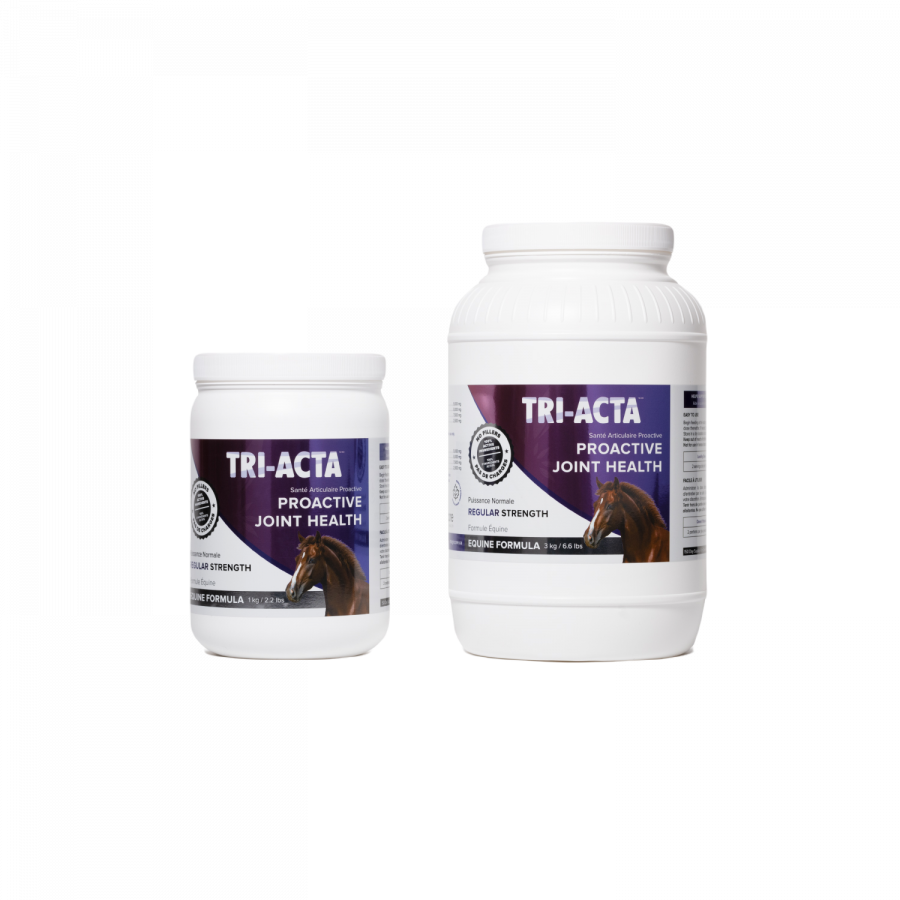
Horse Hoof Care Tools
Proper horse hoof care not only ensures comfort for your horse but also helps prevent various hoof-related issues. To effectively care for your horse's hooves, you'll need the right tools for the job.
Here are some essential horse hoof care tools that every horse owner should have in their grooming kit:
Horse Hoof Pick
A horse hoof pick is the most basic yet indispensable tool for hoof care. Its primary function is to remove dirt, rocks, and debris from the hooves, helping to prevent thrush and other infections.
The hoof pick typically features a sturdy handle and a metal pick with a hooked end, allowing you to scrape dirt and debris from the crevices of the hoof. Regular use of a hoof pick, particularly after riding or turnout, helps keep your horse's hooves clean and healthy.
Hoof Knife
This is a specialized tool designed for trimming and shaping the hoof. A hoof knife features a sharp, curved blade that allows for precise trimming of excess hoof growth and the removal of loose or damaged hoof tissue.
Hoof knives come in various styles and sizes to accommodate different trimming techniques and preferences. When used correctly by a skilled farrier or horse hoof care professional, a hoof knife can help maintain proper hoof balance and prevent issues such as overgrowth and distortion.
Hoof Rasp
A hoof rasp is a versatile tool for shaping and smoothing the hoof wall after trimming. It features a rough, abrasive surface that allows you to file down rough edges, remove excess hoof material, and create a smooth, even surface on the hoof.
Hoof rasps come in different grades of coarseness, ranging from fine to coarse, allowing you to achieve the desired level of finish on the hoof. Regular use of a hoof rasp helps maintain proper hoof shape and promotes healthy hoof growth.
Hoof Nippers
Hoof nippers are heavy-duty cutting tools designed to trim the hoof wall and remove excess length. They feature sharp, serrated blades that make clean, precise cuts, allowing you to remove overgrown hoof material easily.
This horse hoof care tool has various sizes and styles to accommodate different hoof sizes and trimming techniques. When used correctly by a skilled farrier, hoof nippers can help maintain proper hoof length and prevent overgrowth and uneven wear.
Hoof Brush
A hoof brush is a simple yet essential tool for grooming and finishing touches after horse hoof care. It typically features stiff bristles that help remove dirt, dust, and debris from the surface of the hoof, leaving it clean and polished.
In addition to cleaning the hooves, a hoof brush can also be used to apply hoof conditioners or dressings for added protection and moisture. Regular brushing helps keep the hooves healthy and enhances their appearance.
Best Horse Hoof Supplements & Products
Incorporating the right horse supplements and products into their care routine can make a significant difference in maintaining the health and integrity of your horse's hooves. Among the many options available, several stand out for their effectiveness and proven benefits.
Let's check out some of the best horse hoof care supplements and products that can help support your equine companion's hoof health.
Integricare TRI-ACTA H.A. Joint Supplement
Integricare TRI-ACTA H.A. Joint Supplement is highly esteemed for its comprehensive support for joint health, rendering it an exceptional choice for horses encountering hoof issues associated with joint discomfort or inflammation. Our supplement integrates three pivotal ingredients: glucosamine, MSM, and chondroitin sulfate, alongside the inclusion of hyaluronic acid (HA) to bolster joint lubrication and mobility.
Let's take a closer look at our supplement's active ingredients and their functions.
|
Active Ingredient |
Function |
|
Glucosamine |
Vital for cartilage repair and maintenance |
|
MSM |
Exhibits anti-inflammatory properties |
|
Chondroitin Sulfate |
Essential for cartilage health and elasticity |
|
Hyaluronic Acid (HA) |
Enhances joint flexibility and cushioning |
What separates Integricare TRI-ACTA H.A. Joint Supplement from the rest is its formulation of active ingredients, meticulously crafted to address multiple facets of joint health. This approach aids cartilage regeneration, diminishes inflammation, and augments joint lubrication.
Consequently, our supplement supports overall joint function and indirectly benefits hoof health by mitigating underlying joint issues that may contribute to lameness or discomfort.
Whether your equine companion is a competitive athlete or a cherished member of your family, adding Integricare TRI-ACTA H.A. Joint Supplement into their daily regimen can promote long-term joint health and mobility, ensuring they maintain joyous and active lives for years to come.
TRI-ACTA H.A. for Equine
Our maximum strength formula is perfect for horses that are ageing, experiencing arthritis and stiffness, are in training and competition, or under a heavy workload.
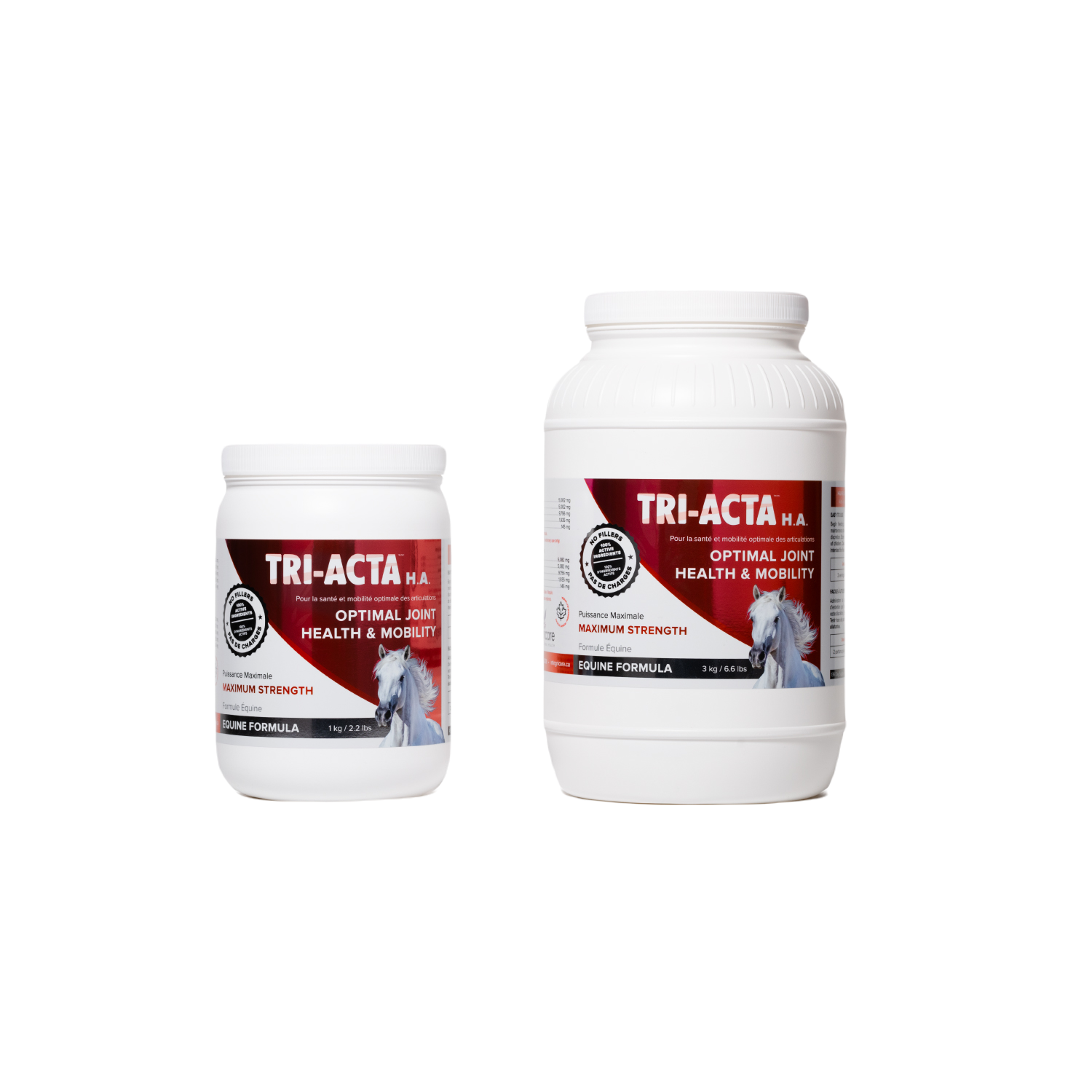
Starts at $129.99 CAD for a 1kg container. Pricing as of March 2024.
Keratex Hoof Hardener
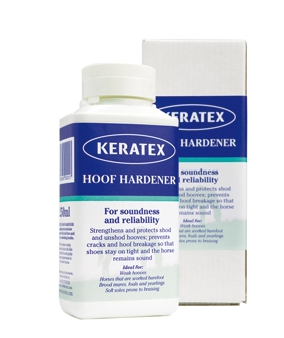
Keratex Hoof Hardener is a trusted and widely used product designed to strengthen and protect your horse's hooves. Its unique formula works by cross-linking keratin molecules within the hoof wall, effectively increasing its density and resilience to wear and tear.
By forming a solid molecular bond, Keratex Hoof Hardener helps prevent cracks, chips, and other forms of hoof damage, making it an ideal choice for horses with weak or brittle hooves.
One of the key benefits of Keratex Hoof Hardener is its ability to improve hoof quality over time with regular use. The product penetrates deep into the hoof structure, reinforcing weak areas and promoting healthier hoof growth from within.
Irrespective of whether your horse is prone to hoof cracks, splits, or excessive wear, incorporating Keratex Hoof Hardener into their hoof care routine can provide long-lasting protection and support for optimal hoof health.
Starts at $69.95 CAD for 250 ml. Pricing as of March 2024.
Farnam Horseshoer's Secret Hoof Conditioner
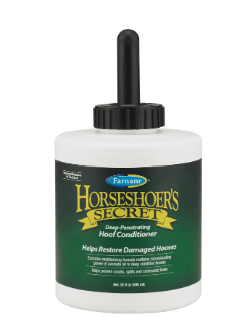
Farnam Horseshoer's Secret Hoof Conditioner is a top-rated product known for its ability to nourish, moisturize, and condition your horse's hooves.
Formulated with essential oils, lanolin, and other natural ingredients, this hoof conditioner penetrates deep into the hoof wall to hydrate and strengthen from the inside out. It replenishes moisture and nutrients lost through environmental factors and daily wear while helping maintain optimal hoof flexibility and resilience.
What we love about Farnam Horseshoer's Secret Hoof Conditioner is its fast-absorbing formula, which delivers immediate results without leaving a greasy residue. This makes it easy to apply and suitable for horses in all disciplines, from competitive athletes to leisure companions.
$33.96 CAD for a 946 ml bottle. Pricing as of March 2024.
Horse Hoof FAQs
Understanding the nuances of horse hoof care is vital for every equine enthusiast. This FAQ section explores common questions surrounding hoof health, from the effectiveness of natural care methods to the best supplements for promoting growth.
Is Natural Horse Hoof Care Worth Considering?
Natural horse hoof care emphasizes regular trimming, balanced nutrition, and ample turnout on varied terrain to mimic wild conditions. While it can strengthen hooves and prevent issues, consult a professional for suitability.
What's the Best Supplement for Horse Hoof Growth?
Supplements containing biotin, methionine, zinc, and copper support hoof growth. Supplements containing ingredients like glucosamine and chondroitin support the regeneration of lateral cartilage with the hoof. TRI-ACTA is an excellent choice as a preventative supplement to support your horse’s hoof health, even if your horse doesn’t currently have any issues with their hooves. If your horse is older or experiencing signs of lameness due to issues with their hooves or other joints in their body, incorporating TRI-ACTA H.A. (which has the added lubricating power of Hyaluronic Acid) is a great way to give them a boost.
TRI-ACTA H.A. for Equine
Our maximum strength formula is perfect for horses that are ageing, experiencing arthritis and stiffness, are in training and competition, or under a heavy workload.

How Often Should I Trim My Horse's Hooves?
Trimming frequency depends on age, activity, and growth rate. Typically, every 4-8 weeks, but consult with a farrier for a tailored schedule.
What Signs Indicate Hoof Problems?
Signs include lameness, changes in gait, heat or swelling, sensitivity, cracks, abnormal growth, color or texture changes, foul odor, or discharge. Promptly consult a vet or farrier for evaluation.
How Can I Prevent Hoof Issues?
Prevention involves balanced nutrition, a clean environment, regular farrier visits, exercise on varied terrain, monitoring for abnormalities, and proactive veterinary care.
Horse Hoof Care—Final Thoughts
Prioritizing fundamental horse hoof care is paramount for every horse owner. Understanding common issues, implementing preventive measures, and investing in quality horse hoof care ensures your equine companion maintains optimal health and overall well-being.
Choosing the right supplements plays a crucial role. Integricare is a top equine supplement provider, offering solutions like the TRI-ACTA H.A. Joint Supplement renowned for its comprehensive support for joint health.
With a blend of essential active ingredients and a focus on promoting mobility and comfort, Integricare empowers you to keep your horse healthy, happy, and mobile for years to come.
Check out our equine supplements and make us your partner in ensuring your horse's ongoing vitality and performance excellence.
TRI-ACTA H.A. for Equine
Our maximum strength formula is perfect for horses that are ageing, experiencing arthritis and stiffness, are in training and competition, or under a heavy workload.

Newsletter Signup
Subscribe to our newsletter to receive the latest news and exclusive offers.
.jpg?height=2000&name=Cliick_Integricare-DISPLAY-REVISEDV2%20(1).jpg)
Proactive & Therapeutic Joint Supplements
When given daily, Integricare joint supplements recover bone and joint injuries faster and help prevent mobility injuries from happening in the first place.

